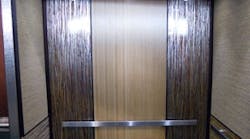During a building renovation, the elevator is frequently ignored – many building owners are satisfied if the elevator is still running and the wear and tear isn’t too glaring.
However, the elevator offers a prime opportunity for affordable updates, especially if you’re in the midst of greening the building. Use the 150 square feet to create a microcosm of your building’s commitment to sustainability while refreshing the elevator’s appearance and efficiency.
Give It a Green Facelift
Aesthetic upgrades are an affordable way to refresh the cab’s appearance, and using green materials in your renovation not only shows off your company’s green commitment, but also provides a boost to IAQ.
Addressing the walls is a great place to start. Try a few coats of low-VOC paint to bring the cab’s appearance up to date. If you need to replace paneling, look for replacement panels crafted from rapidly renewable materials, such as bamboo or plyboo, with no added urea formaldehyde. Some vendors may offer the option of low- or no-VOC glues to install the panels.
“Cab interiors can be easily replaced with new environmentally friendly particle board, substrates, and laminates, all low-emitting products,” says Brad Nemeth, director of sustainability for ThyssenKrupp Elevator Americas.
Even traditional interiors could be considered green if you choose the most durable products, adds John King, co-founder of elevator remodeling firm Cab Solutions. Less frequent replacement means less product heads to the landfill, and some products, like plastic laminate, can be recycled.
“Plastic laminate is a very durable solution, so it’s green to not have to replace it too much,” King says. “So is stainless steel, and even if you have vinyl floors, those are durable components.”
Fine-Tune the Elevator’s Operations
Replacing the drive offers the most opportunities for energy savings, but putting in a new drive before the old one has outlived its use isn’t financially feasible for most building owners.
Assess the condition of other components in the elevator to find additional opportunities for savings. Replace fluorescent or incandescent lighting with LEDs to reduce costs by up to 80% and dramatically cut down your bulb replacement needs, Nemeth suggests.
“Typically, LED lights last up to 10 years,” Nemeth explains. “They can reduce heat loss typical in other lighting options and disposal issues common with other mercury-containing bulbs. They also don’t emit the ultraviolet light that’s common in other bulbs, which can cause fading to cab interiors over time.”
LEDs also offer a more modern look and require less maintenance, King says: “The old fluorescent diffusers are kind of trash collectors, and they’re dirty. People look at that and want to upgrade them. In many cases, that’s a driver to have a renovation done.”
A basic programming update to the elevator controller will automatically shut off the elevator’s lights and fan between service calls. This eliminates considerable energy waste (up to 60%, according to Nemeth), reduces wear and tear on bulbs, and keeps cabs cooler by cutting down on heat generated by lighting.
“Energy use could go from 24 hours a day to less than 9.5 hours a day, reducing CO2 emissions by 193,000 tons per year,” Nemeth explains.
Pair these optimized controls with new door controls to further increase the elevator’s efficiency. By upgrading the doors, you can improve floor-to-floor times, thus boosting the elevator’s efficiency.
Whichever green tack you take, King says, remember that environmental awareness and a more aesthetically pleasing experience are the top concerns – you won’t get any LEED credits from renovating the elevator, but you can educate consumers on your building’s environmental stewardship and make the ride between floors more pleasant while you’re at it.
“If you renovate elsewhere in your building and not in the elevator, it will be noticeable,” King says. “For instance, in hotels and high-rises, people spend a lot of time in the elevator going up and down. The elevator is part and parcel of the experience.”
Janelle Penny ([email protected]) is associate editor of BUILDINGS.



